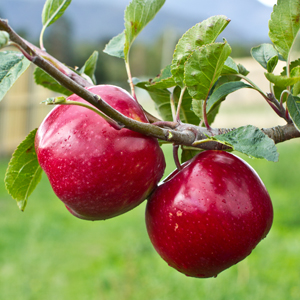Fruit
- Consistent crop loads from year 3. No fruit thinning has been carried out
- Size is not a problem
- Colour and maturity that should allow a minimum number of picks
- Will hang on the tree after the optimum picking time
- Does not get waxy, overripe or fall prematurely
- Tree characteristics Spur, or Semi Spur, Spreading
- Fruit holds well at room temperature
- Taste has seen widespread positive acceptance
Climate
![]() Grows best in warm and cool climates
Grows best in warm and cool climates
Maturity
Julie® comes to full maturity in late Autumn.
![]()
Pollination
Information coming soon.
About Julie™
The original tree was growing as a chance seedling beside an old shed on the Shields property, which has been an orchard since the early 1900’s. The tree was observed to have some fruit about 1992 after apple trees were planted nearby. A number of trees were propagated in 2002 using plant material from the original tree and grafted on to M26 stock. Julie™ was planted in an orchard situation in 2003 and was producing small quantities of fruit in 2005. Observations of the fruit produced have shown consistently to original characteristics. No regression has been observed.In September 2008 the variety was placed in the Australian Pome Fruit Improvement Program for evaluation. The trial sites are located at 3 sites in Australia – Huonville in Tasmania, Adelaide Hills in South Australia and Shepparton in Victoria.Shield applied for Plant Breeders Rights and provisional acceptance was granted 28/02/2012. Trees in comparator trial have had fruit on this year (2014).Currently there are about 350 trees in the ground from 1 year to 10 years old. In 2013 Shield placed a small number of trees with commercial orchards at Orange, Batlow, Darkes Forest and Stanthorpe. There will be around 4000 trees in commercial orchards in 2014.
Disease Resistance
- We have not observed any propensity to apple scab or powdery mildew
- Alternaria observed on Gala. Adjacent Julie, no evidence
- Placed trees in an organic orchard to test disease resistance
- Will conduct own simple infection tests
- Plant material has been certified for known viruses
Origin of Julie™
- Chance seedling
- Observed fruit around 1990’s
- A number of trees propagated around 2002
- Planted in an orchard situation in 2003
- First fruit in 2005
- Have around 350 trees from 2 – 12 years old
- Stable – no evidence of any aggressive tendencies
Development of Julie™
- Placed in AFIP program in 2008 for evaluation
- 3 Sites – Huonville, Shepparton & Lenswood
- PBR applied for in 2011. Provisional acceptance 28/02/12
- Anticipate PBR to be completed in 2015
- May 2014 applied to trademark name ‘Julie’. Granted in April 2015
- Currently have trial sites in 19 commercial orchards. We anticipate some commercial quantities of fruit as of 2016
- August 2014 applied for ‘Julz’ trademark for use overseas. Commenced trademarking in 46 countries in March 2015.

